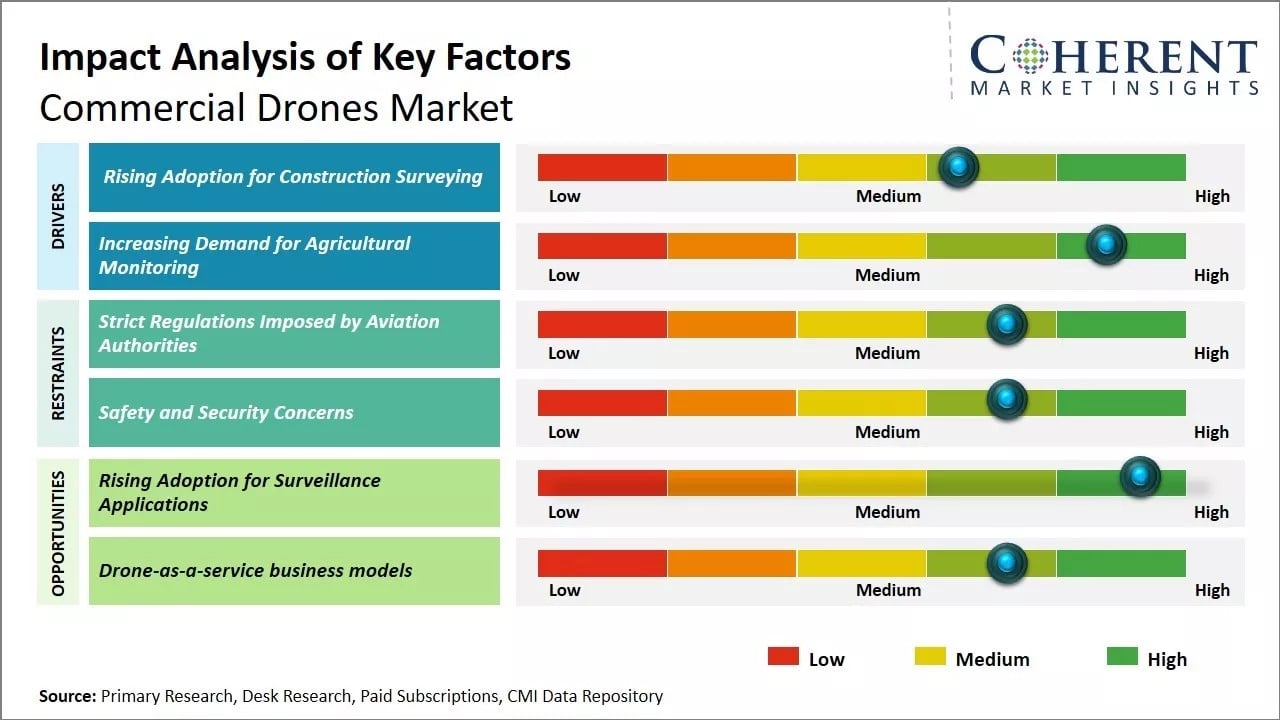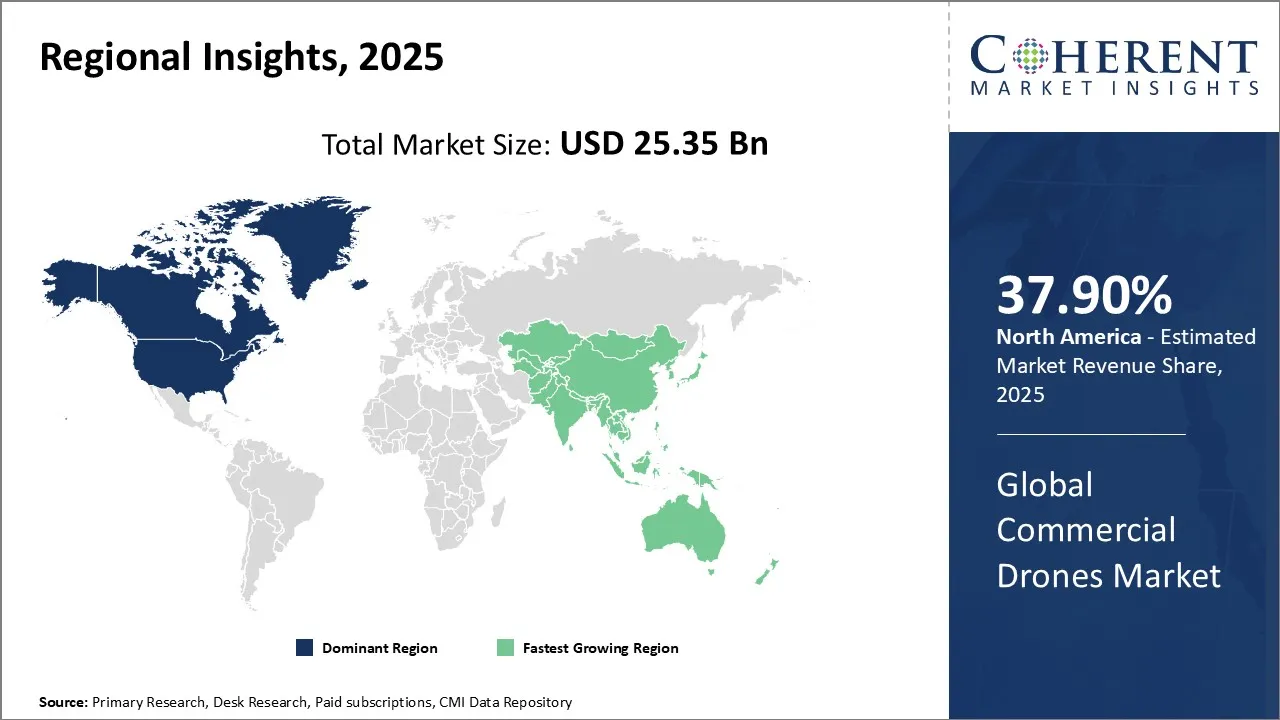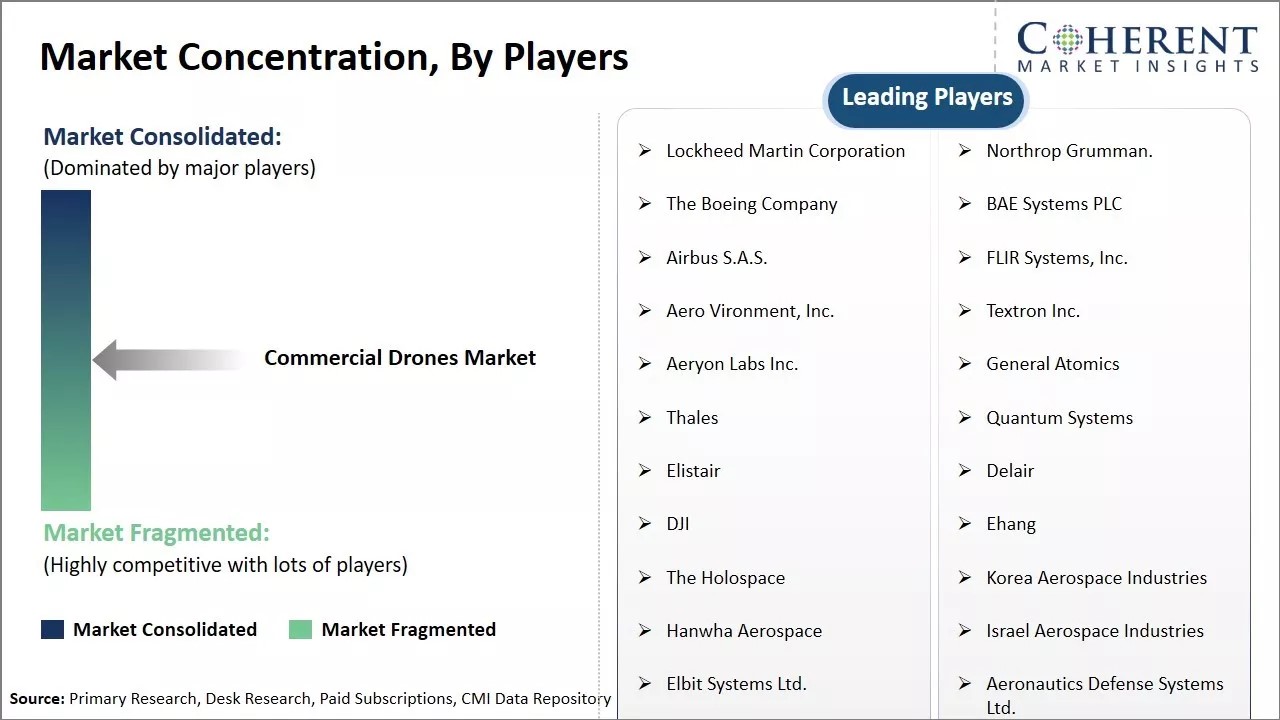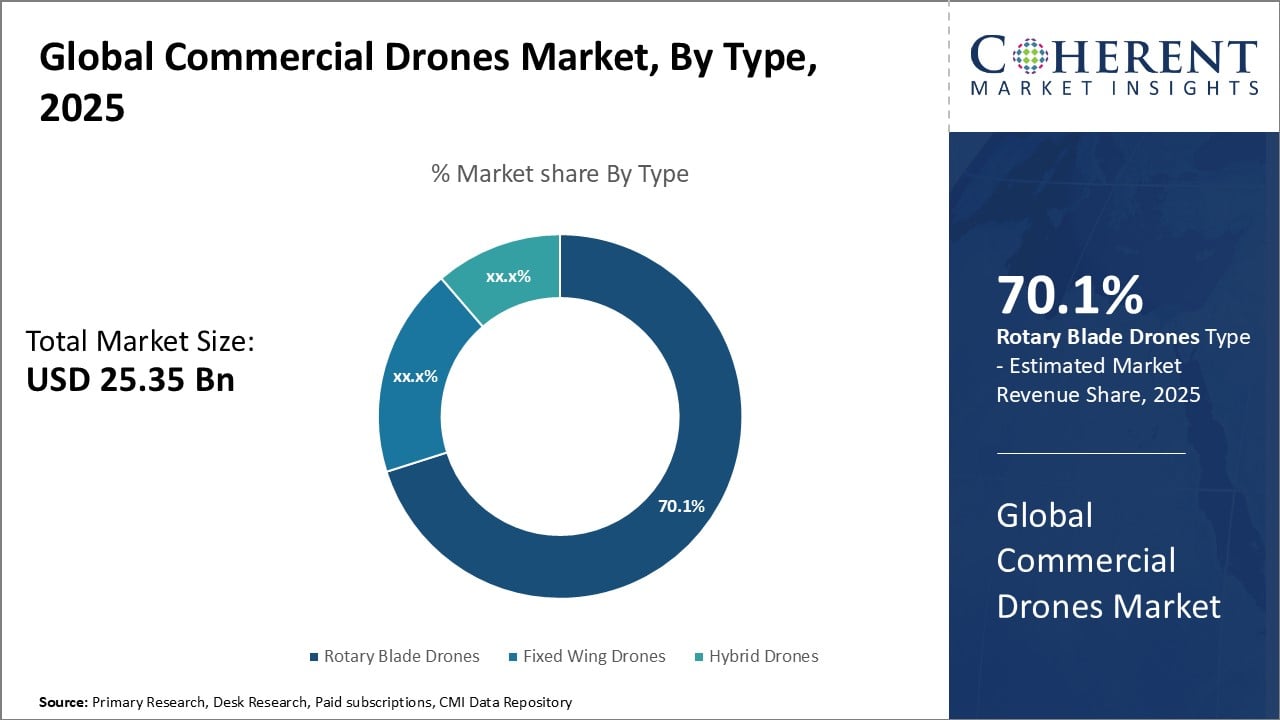Commercial Drones Market Size and Trends: 2025 to 2032
The Commercial Drones Market is estimated to be valued at USD 25.35 Bn in 2025 and is expected to reach USD 62.30 Bn by 2032, exhibiting a compound annual growth rate (CAGR) of 13.7% from 2025 to 2032.
Key Takeaways
- Based on Type, the Rotary Blade Drones segment is expected to lead the market with 70.1% share in 2025, driven by versatility, affordability, and broad industry use.
- Based on Maximum, the Drones Under 2 Kilograms segment is projected to capture the highest share of the market in 2025, due to ease, accessibility, and compliance, while heavier models serve niche uses.
- Based on Duration, the More Than 30 Minutes segment is projected to account for the largest share of the market in 2025, driving professional use in surveying, agriculture, and inspection.
- Based on Range, the short-range drone, under 25 kilometers segment is expected to lead the market with maximum share in 2025, owing to affordability and regulation compliance, while long-range drones serve niche sectors.
- Based on Application, the Aerial Photography segment is expected to hold the 38.7% share of the market in 2025, by revolutionizing imaging across industries with cost-effective precision.
- Based on Region, North America is set to lead the commercial drones market with 37.9% share in 2025. While, Asia Pacific is anticipated to be the fastest growing region.

To learn more about this report, Download Free Sample
Market Overview
The market growth is majorly driven by the increasing adoption of drones in various industries like agriculture, construction, energy & utilities, logistics, and more. Drones help monitor crops and enable precision agriculture, monitor progress of construction projects, and inspect energy infrastructure like power lines & wind turbines easily which is otherwise difficult and hazardous. This has fueled the growth of the commercial drones market across major regions.
The market is expected to witness high demand owing to the increasing investments by leading technology companies in drones and widespread integration of drones in various applications. Furthermore, rapid advancements in drone hardware, software, and technologies like artificial intelligence, blockchain, etc. are supporting new use cases and thereby driving more opportunities. However, concerns around drone regulations and privacy can hamper the growth during the forecast period.
Current Events and Its Impacts on the Commercial Drones Market
|
Current Event |
Description and its Impact |
|
EU Drone Regulation Framework Implementation |
|
|
5G Network Infrastructure Rollout |
|
Uncover macros and micros vetted on 75+ parameters: Get instant access to report
Role of Artificial Intelligence (AI) in Commercial Drones Market
AI is transforming commercial drones by letting them fly on their own, analyze data in real time, and make decisions that change based on what they learn. Drones powered by AI make farming more accurate, make logistics easier, and make infrastructure inspections better. They use machine learning to find problems, improve flight paths, and cut down on the need for human help. By 2025, more than 60% of new commercial drones are expected to have AI built in. This will make them more efficient, scalable, and useful in more industries, which is going to assist the global market grow.
For instance, in November 2025, the launch of VANA by IZI, India's first AI-enabled industrial UAV with swappable payloads, is an important milestone forward for commercial drones. It makes things more efficient and flexible for infrastructure, agriculture, and logistics. This new technology makes India a stronger player in the global drone market and shows how AI is becoming more important in business
Commercial Drones Market Insights, By Type - Rotary Blade Drones Dominance Is Driven by Versatility, Affordability, And Broad Industry Use
The rotary blade drone segment is expected to lead the market with 70.1% share in 2025, as they are easy to use, affordable, and can do an abundance of different things. They are great for aerial photography, inspections, and farming considering they can take off and land vertically. Fixed-wing drones are still the best choice for long-range mapping, but hybrid drones are becoming more popular, though they are not yet widely used.
For instance, in August 2025, UAVOS will make composite main rotor blades for the unmanned helicopters of Spanish company Avincis. These rotary-wing UAVs are more durable, efficient, and powerful. The new technology shows how rotary blade technology continues to advance better in both specialized aviation and commercial drone ecosystems in 2025, even though it is far larger than most commercial drones.
Commercial Drones Market Insights, By Maximum Takeoff Weight - Drones Under 2 Kilograms Dominates for Ease, Accessibility, And Compliance, While Heavier Models Serve Niche Uses
The drone weighing less than 2 kilograms segment is expected to hold the largest share of the market in 2025, favored for their straightforward to use, accessible, and regulatory compliance. These small drones are often used for taking pictures from the air and checking things out. Drones that weigh more than 5 kilograms are used for specific purposes like logistics or defense, but they are not utilized as much as due to stricter rules.
For instance, in September 2025, Blaze Drone is India's smallest homegrown UAV and weighs less than 250 grams, which puts it in the sub-2 kg range. BotLab Dynamics made it, and it can be used for aerial photography, surveillance, and swarm operations. Its light weight makes it easy to use, meets all the rules, and fits in with the most popular market segment for small drones in 2025.
Commercial Drones Market Insights, By Duration - Drones with More Than 30 Minutes Flight Time Lead Is Driving Professional Use in Surveying, Agriculture, And Inspection
The more than 30 minutes segment is projected to account for the highest share of the market in 2025. This is due to longer flight times are needed for surveying, monitoring agriculture, and inspecting factories. Longer duration makes things work better and less time is wasted. Drones that fly for less than 30 minutes are still popular with hobbyists and casual users, but they do not belong to as useful for professional use.
For instance, in August 2025, the SiFly Q12 drone can fly for more than 30 minutes, which is longer than most drones can fly, to meet the needs of professionals. Its long duration makes it useful for surveying, monitoring agriculture, mapping, and industrial inspections, which significantly decreases down on downtime and increases efficiency. This breakthrough reveals how long-duration drones are changing markets in 2025, moving from being used for fun to being used for important tasks.
Commercial Drones Market Insights, By Range - Short-Range Drones Dominates for Affordability and Regulation Compliance, While Long-Range Drones Serve Niche Sectors
The short-range drone, under 25 kilometers segment is projected to capture the greatest share of the market in 2025, as the majority commercial uses need them to work in a specific area. They are the best choice as they are useful, affordable, and follow aviation rules. Long-range drones that can fly more than 25 kilometers are becoming more popular in niche areas like mapping and defense, but they are still not widely used.
For instance, in April 2025, DJI's new Mavic 4 Pro and Mini 5 Pro demonstrate that short-range drones under 25 kilometers still rank as the best. They are made for small-scale tasks like aerial photography and inspections, and they strike a good balance between usefulness, cost, and following the rules. This is why short-range drones will have the greatest market penetration in commercial applications in 2025.
Commercial Drones Market Insights, By Application - Aerial Photography Leads by Revolutionizing Imaging Across Industries with Cost-Effective Precision
Aerial Photography segment is estimated to contribute the highest share of 38.7% in 2025 in the market. Commercial drones have revolutionized the aerial photography sector by providing easy, safe, and cost-effective solutions. Drone-based photography is rapidly replacing traditional techniques using helicopters, aircraft, and cranes. It allows high-resolution images and videos from different angles, terrains, and locations that were previously impossible. As a result, aerial photography is finding widespread usage in real estate, filmmaking, event coverage, architecture, and more. The ability to accurately capture landscapes, buildings, mining sites, and other properties helps industries with inspection, mapping, and marketing needs. Drones also give aerial photographers an edge over competitors by providing unique perspectives.
For instance, the A1 drone from Antigravity is scheduled to launch in January 2026. It has a high-resolution camera, a stabilized gimbal, a longer flight time, and AI-assisted modes, making it perfect for people who enjoy clicking pictures and videos from the air. The A1 is up against competitors like DJI and aims to attract creators, professionals, and hobbyists who want high-quality images.
Regional Insights

To learn more about this report, Download Free Sample
North America Commercial Drones Market Analysis & Trends
North America has firmly established itself as the dominant region in the global commercial drones market and is estimated to hold the market share of 37.9% in 2025. The early adoption of commercial drones by various industries such as agriculture, insurance, construction and filmmaking has given North American companies a significant headstart over others. A highly developed manufacturing base and major presence of industry giants like DJI has cemented North America's position as the leader in commercial drone technology and UAV applications. The region is also aggressively investing in research around drone AI, sensors and autonomous flights which will drive further innovation in commercial applications.
For instance, in December 2025, a new drone factory in Louisiana makes North America even more powerful in the commercial drone market in 2025. It helps farming, logistics, inspections, and public safety by increasing local production. This growth shows the region's leadership by making sure the supply chain is strong and meeting the growing need for professional drone applications.
Asia Pacific Commercial Drones Market Analysis & Trends
Asia Pacific is emerging as the fastest growing regional market. Countries like China, Japan and South Korea are aggressively promoting commercial drones with support from their governments. China, in particular, has ambitions of becoming a global leader in this sector and is offering favorable policies to both local manufacturers as well as foreign players looking to tap into its massive market potential. Coupled with lower manufacturing and labor costs compared to developed markets, Asia Pacific offers an attractive value proposition for commercial drone OEMs and technology providers. Rising disposable incomes are also fueling demand for innovative commercial drone applications across industries in the region.
For instance, in November 2025, with a new Drone Act and a national master plan, Thailand is moving forward with the use of commercial drones. In 2024, the number of registered drones shot up to almost 28,000, and it's expected to reach over a million soon. Thailand is becoming a fast-growing hub in Southeast Asia's drone market because drones can be used for farming, logistics, inspections, and transporting people.
Commercial Drones Market Outlook Country-Wise
The U.S. Commercial Drones Market Trends
The U.S. commercial drone market is growing quickly because they are being used regularly in agriculture, logistics, construction, and defense. Advanced FAA rules, AI integration, and "drone-as-a-service" models all aid in saving funding and make things more efficient. Local production and new ideas drive demand even more, making the U.S. the clear leader in drone applications around the world.
For instance, in October 2025, with its new drone factory in Lafayette, DMR Technologies makes North America even more dominant in the commercial drone market in 2025. The plant makes unmanned aerial systems for agriculture, logistics, inspections, and public safety. It makes the supply chain more resilient and meets the growing demand for professional drone applications across the United States.
China Commercial Drones Market Trends
In 2025, China's commercial drone market is extremely strong since the government supports it strongly, cities are growing quickly, and there are smart city projects. China is the world's manufacturing center, led by DJI and new startups. It drives innovation in agriculture, logistics, and inspections, which boosts both domestic use and exports while also expanding the use of advanced drones.
For instance, in January 2025, China's Mach 4 commercial drone, which is scheduled for its first flight next year, shows that the country wants to be the leader in drone technology around the world. It has ultra-fast speeds for logistics, inspections, and business use, which expands its commercial uses beyond just photography and agriculture. This shows that China is still the leader in advanced drone technology and manufacturing.
Market Report Scope
Commercial Drones Market Report Coverage
| Report Coverage | Details | ||
|---|---|---|---|
| Base Year: | 2024 | Market Size in 2025: | USD 25.35 Bn |
| Historical Data for: | 2020 To 2024 | Forecast Period: | 2025 To 2032 |
| Forecast Period 2025 to 2032 CAGR: | 13.7% | 2032 Value Projection: | USD 62.30 Bn |
| Geographies covered: |
|
||
| Segments covered: |
|
||
| Companies covered: |
Lockheed Martin Corporation, Northrop Grumman., The Boeing Company, BAE Systems PLC, Airbus S.A.S., FLIR Systems, Inc., Aero Vironment, Inc., Textron Inc., Aeryon Labs Inc., General Atomics, Thales, Quantum Systems, Elistair, Delair, DJI, Ehang, The Holospace, Korea Aerospace Industries, Hanwha Aerospace, Israel Aerospace Industries, Elbit Systems Ltd., and Aeronautics Defense Systems Ltd. |
||
| Growth Drivers: |
|
||
| Restraints & Challenges: |
|
||
Uncover macros and micros vetted on 75+ parameters: Get instant access to report
Commercial Drones Market Driver
Rising Adoption for Construction Surveying
The construction industry has always relied on conventional methods for surveying buildings, structures, and large construction sites. Projects often involved human surveyors manually documenting dimensions, heights, contours, and other site specifications using traditional tools like measuring tapes, theodolites, and GPS receivers. However, this process was time-consuming, labor-intensive, and posed safety risks to surveyors working at heights or in difficult terrains. Drones have the potential to revolutionize construction surveying by automating much of the data collection process and improving both efficiency and safety. Compared to traditional methods, commercial drones equipped with advanced cameras and sensors can survey large areas much faster while offering bird's-eye perspectives not possible otherwise. They allow collection of high-resolution imagery, 3D models, contour maps and other geospatial data to support various stages of construction from planning and design to progress monitoring. Drones minimize the need for human surveyors to work at dangerous heights or enter confined spaces on site. Their ability to rapidly survey inaccessible areas makes them especially useful for projects involving assets in remote locations or difficult terrains. Many construction companies have already recognized these benefits and are increasingly adopting drone technology for surveying existing structures as well as monitoring ongoing projects. As construction projects grow in scale and complexity worldwide, commercial drones have the potential to significantly boost productivity and safety standards in the surveying process across the industry.
Increasing Demand for Agricultural Monitoring
Agriculture has always relied on manual field monitoring methods to inspect crops, analyze soil conditions and identify pests or diseases. Farmers and agronomists would physically walk through fields to gather this vital information, which is a time-consuming and labor-intensive process. Commercial drones have the ability to revolutionize agricultural monitoring by automating data collection and enabling remote inspection of vast crop areas. Equipped with optical and thermal cameras, drones can capture high-resolution aerial images and videos of entire fields. Sophisticated analytics tools then process this visual data to monitor crop health, detect issues like infestations, estimate yields and more. Drones eliminate the need for physical scouting and allow farmers to continuously monitor scattered or remote farmlands from the comfort of their office. They prove especially useful for large-scale, commercial farming operations. By rapidly collecting imagery over broad regions, drones give agronomists a bird's-eye view of entire properties to identify issues early.
Commercial Drones Market Opportunities
Rising Adoption in Agriculture and Surveillance Applications
Drones can enable cost-effective inspection of critical assets like oil and gas pipelines, cellular towers, and wind turbines. Their deployment can streamline agriculture, photography, filmmaking, delivery, and surveillance applications. Emerging technologies in artificial intelligence, computer vision, and edge computing are improving drone autonomy.
Market Concentration and Competitive Landscape

To learn more about this report, Download Free Sample
Analyst Opinion (Expert Opinion)
- The market for commercial drones is moving from an early stage where hardware was the main focus to a more mature stage where services are the main focus. Leading research firms' evaluations of the industry show that reported market size varies widely because of different definitions of commercial use, the inclusion of software and analytics, and the scope of delivery services. Even though the numbers are different, all of the datasets show that the number of professional drones and missions continue to keep growing.
- Regulatory registries show that a lot of people are using drones. For example, the FAA has recorded hundreds of thousands of commercial drone registrations and tens of millions of unmanned flights each year. This scale shows that there is a lot of demand for surveying, mapping, inspecting energy infrastructure, precision agriculture, and new logistics corridors. Operators who focus on delivery are also showing operational maturity, with major players completing more than a million deliveries and logging a lot of autonomous flight hours.
- More and more, data services, analytics subscriptions, and managed inspection programs are driving growth instead of standalone hardware. Improvements in autonomy, navigation, and long-range communication systems are making it possible for drones to operate beyond the line of sight, which makes them more useful in both industrial and urban settings. But different rules in different countries and complicated approval processes still make it hard to roll out widely, especially in big cities.
- Overall, the market is getting stronger as more missions are being automated, software platforms are getting better, and more businesses are finding new uses for them. Regulated industrial corridors, healthcare logistics, and high-frequency inspection operations are the best short-term opportunities.
Recent Developments
- In December 2025, Avironix's AviSpray 10C, a backpack-sized drone for spraying crops, helps India's precision farming industry. It lowers costs and increases efficiency by reducing the amount of work needed for crop spraying. This new development shows how much India needs commercial drones. It will assist in agriculture and make advanced drone technology more widely used across the country.
- In October 2025, IG Drones' new advanced manufacturing facility in Uttar Pradesh is going to make India's commercial drone industry stronger. The plant improves domestic innovation and production by focusing on agriculture, infrastructure inspection, disaster management, and logistics. This expansion shows that rapidly India is becoming a major player in the global drone market, which is driving adoption and making the country a key player.
Market Segmentation
- Type Insights (Revenue, USD Bn, 2025 - 2032)
- Fixed Wing Drone
- Rotary Blade Drone
- Hybrid Drone
- Maximum Takeoff Weight Insights (Revenue, USD Bn, 2025 - 2032)
- Less than 2 KG
- Between 2–5 KG
- More than 5 KG
- Duration Insights (Revenue, USD Bn, 2025 - 2032)
- Less than 30 Min
- More than 30 Min
- Range Insights (Revenue, USD Bn, 2025 - 2032)
- Short (<25 Kilometers)
- Long (25 Kilometers)
- Application Insights (Revenue, USD Bn, 2025 - 2032)
- Aerial Photography
- Agriculture
- Emergency and Disaster Management
- Inspection & Monitoring
- Remote Sensing & Mapping
- Wildlife Research & Preservation
- Regional Insights (Revenue, USD Bn, 2025 - 2032)
- North America
- U.S.
- Canada
- Latin America
- Brazil
- Argentina
- Mexico
- Rest of Latin America
- Europe
- Germany
- U.K.
- Spain
- France
- Italy
- Russia
- Rest of Europe
- Asia Pacific
- China
- India
- Japan
- Australia
- South Korea
- ASEAN
- Rest of Asia Pacific
- Middle East & Africa
- GCC Countries
- Israel
- Rest of Middle East & Africa
- Key Players Insights
- Lockheed Martin Corporation
- Northrop Grumman.
- The Boeing Company
- BAE Systems PLC
- Airbus S.A.S.
- FLIR Systems, Inc.
- Aero Vironment, Inc.
- Textron Inc.
- Aeryon Labs Inc.
- General Atomics
- Thales
- Quantum Systems
- Elistair
- Delair
- DJI
- Ehang
- The Holospace
- Korea Aerospace Industries
- Hanwha Aerospace
- Israel Aerospace Industries
- Elbit Systems Ltd.
- Aeronautics Defense Systems Ltd.
Sources
Primary Research Interviews
- Commercial Drone Manufacturers
- UAV Platform & System Integrators
- Drone Software & Analytics Providers
- Remote Pilots & Drone Fleet Operators
- Aerial Surveying & Inspection Service Providers
- Agriculture, Construction & Energy Sector End-Users
- Aviation Regulators & Airspace Management Experts
- Others
Databases
- Bloomberg Terminal
- Thomson Reuters Eikon
- IHS Markit
- Euromonitor International
- S&P Global Market Intelligence
- Frost & Sullivan
- Others
Magazines
- DroneLife Magazine
- Commercial UAV News
- Unmanned Systems Magazine
- Aerospace America
- Geospatial World Magazine
- Others
Journals
- Journal of Field Robotics
- IEEE Transactions on Robotics
- International Journal of Remote Sensing
- Unmanned Systems Journal
- Sensors Journal (MDPI)
- Others
Newspapers
- Financial Times
- The Wall Street Journal
- Reuters
- Bloomberg News
- The Guardian (Technology Section)
- Others
Associations
- Association for Uncrewed Vehicle Systems International (AUVSI)
- International Civil Aviation Organization (ICAO) – UAV / UAS Programs
- European Union Aviation Safety Agency (EASA)
- Federal Aviation Administration (FAA) – UAS Integration Office
- Global UTM Association (GUTMA)
- Others
Public Domain Sources
- U.S. Federal Aviation Administration (FAA) – UAS Data Hub
- European Union Aviation Safety Agency (EASA) – Drone Regulations
- International Civil Aviation Organization (ICAO)
- World Bank Open Data
- National Aeronautics and Space Administration (NASA) – UTM Research
- Others
Proprietary Elements
- CMI Data Analytics Tool
- Proprietary CMI Existing Repository of Information for the Last 8 Years
Share
Share
About Author
Suraj Bhanudas Jagtap is a seasoned Senior Management Consultant with over 7 years of experience. He has served Fortune 500 companies and startups, helping clients with cross broader expansion and market entry access strategies. He has played significant role in offering strategic viewpoints and actionable insights for various client’s projects including demand analysis, and competitive analysis, identifying right channel partner among others.
Missing comfort of reading report in your local language? Find your preferred language :
Transform your Strategy with Exclusive Trending Reports :
Frequently Asked Questions
EXISTING CLIENTELE
Joining thousands of companies around the world committed to making the Excellent Business Solutions.
View All Our Clients

